Heterosis for yield and its components in okra (Abelmoschus esculentus L. Moench)
Bạn đang xem bản rút gọn của tài liệu. Xem và tải ngay bản đầy đủ của tài liệu tại đây (267.29 KB, 15 trang )
Int.J.Curr.Microbiol.App.Sci (2019) 8(1): 353-367
International Journal of Current Microbiology and Applied Sciences
ISSN: 2319-7706 Volume 8 Number 01 (2019)
Journal homepage:
Original Research Article
/>
Heterosis for Yield and its Components in Okra
(Abelmoschus esculentus L. Moench)
Prakash Kerure1*, M. Pitchaimuthu2, V. Srinivasa3 and R. Venugopalan4
1
ICAR-Krishi Vigyan Kendra, Chitradurga 577 598, Karnataka, India
ICAR-Indian Institute of Horticultural Research, Bengaluru-560 089, Karnataka, India
3
University of Agricultural and Horticultural Sciences, COH, Mudigere, Karnataka, India
4
ICAR-Indian Institute of Horticultural Research, Bengaluru-560 089, Karnataka, India
2
*Corresponding author
ABSTRACT
Keywords
Abelmoschus
esculentus, F1
hybrids, Heterotic
pattern, Hybrid
vigour, Parental
lines
Article Info
Accepted:
04 December 2018
Available Online:
10 January 2019
The study of heterosis would help in selection of heterotic crosses for commercial
exploitation of F1 hybrids in okra (Abelmoschus esculentus (L.) Moench). 45 F1s were
developed by crossing 10 elite lines of okra in half diallel fashion during summer 2016.
All 45 F1s along with their 10 parents and one standard control (Nunhems hybrid Shakti)
were evaluated in a randomized complete block design with three replicates during late
kharif (July to October) 2016 at ICAR- Krishi Vigyan Kendra, Babbur Farm, Hiriyur,
Chitradurga, Karnataka, India, for heterosis of yield and its components of okra.
Significance of mean squares due to genotypes revealed the presence of considerable
genetic variability among the material studied for almost all yield and yield attributes. The
overall maximum positive significant heterosis for total yield per plant was observed in
cross IIHR-875 x IIHR-478 (112.89%) over relative heterosis, (83.78%) over
heterobeltiosis and (168.55%) over standard heterosis. Negatively heterotic crosses like
IIHR-562 x IIHR-444 for days to 50% flowering (-8.70%) and IIHR-567 x IIHR-107 for
fruiting nodes (-9.03%) respectively, are important to exploit heterosis for earliness in
okra. Out of 45 F1s, 44 F1s crosses exhibit significant standard heterosis in any given
direction for total yield per plant except cross IIHR-604 x IIHR-107 (-0.13%). The F1
hybrid IIHR-875 x IIHR-478 with high yield potential has the potential for commercial
cultivation after further evaluation for late kharif season of Karnataka.
important vegetable crop in India. Among the
vegetables grown in India, okra occupies fifth
position, next to tomato in area. Yield plateau
seems to have been reached in openpollinated varieties of okra. However, it could
be improved through hybridization. Marked
heterosis of 38 to 71 percent has been
reported in okra for yield and its components
Introduction
Okra is originated in tropical Africa. It is an
introduced vegetable crop in India. Although,
it is a multipurpose and multifarious crop, it is
extensively grown for its tender pods, which
are used as a very popular, tasty and
gelatinous vegetable. Okra is the most
353
Int.J.Curr.Microbiol.App.Sci (2019) 8(1): 353-367
(Laxmiprasanna, 1996, Singh et al., 1975).
Heterosis breeding has been the most
successful approach in increasing the
productivity in cross-pollinated vegetable
crops. Okra is one often-cross pollinated
vegetable crop where the presence of
heterosis was demonstrated for the first time
by Vijayaraghavan and Warrier (1946). Since
then, heterosis for yield and its components
were extensively studied. Selection of parents
on the basis of phenotypic performance alone
is not a sound procedure. It is therefore
essential that parents should be chosen on the
basis of their combining ability. The half
diallel mating design has been used in the
present study to assess the genetic
potentialities of the parents in hybrid
combination through systematic studies in
relation to general and specific combining
abilities which are due to additive and nonadditive gene effects respectively (Griffing,
1956; Kempthrone, 1957). Several research
workers have reported occurrence of heterosis
in considerable quantities for fruit yield and
its various components (Venkataramani,
1952; Joshi et al., 1958; Partap and Dhankar,
1980; Elangovan et al., 1981; Partap et al.,
1981; Mehta et al., 2007; Weerasekara et al.,
2007; Jindal et al., 2009). The ease in
emasculation and very high percentage of
fruit setting indicates the possibilities of
exploitation of hybrid vigour in okra. The
presence of sufficient hybrid vigour is an
important
prerequisite
for
successful
production of hybrid varieties. Therefore, the
heterotic studies can provide the basis for the
exploitation of valuable hybrid combinations
in the future breeding programmes and their
commercial utilization. Variation in most of
the agronomical and horticultural traits is
available in the germplasm of cultivated okra
(Dhall et al., 2003; Singh et al., 2006; Dakahe
et al., 2007; Mohapatra et al., 2007; Reddy,
2010). The initial selection of parents to be
involved in any effective hybridization
programme depends upon the nature and
magnitude of relative heterosis (heterosis over
mid parent), heterobeltiosis (heterosis over
better parent), and economic heterosis
(heterosis over check) present in genetic
stocks. Heterosis breeding based on the
identification of the parents and their cross
combinations is capable of producing the
highest level of transgressive segregates
(Falconer, 1960). The choice of the best
parental matings is crucial for the
development of superior hybrids and because
combinations of hybrids grow exponentially
with the potential number of parents to be
used, this is one of the most expensive and
time-consuming steps in hybrid development
programmes (Agrawal, 1998). The present
investigation aims primarily to study the
direction and extent of relative heterosis,
heterobeltiosis and economic heterosis for
yield and its associated traits in 10 × 10 half
diallel crosses for utilization of existing
genetic diversity to develop heterotic F1
hybrids in okra.
Materials and Methods
Ten elite and nearly homozygous lines of okra
namely IIHR -875, IIHR -478, IIHR- 604,
IIHR- 567, IIHR- 182, IIHR- 595, IIHR- 562,
IIHR- 347, IIHR- 444, IIHR-107 selected
from the germplasm collected by ICARIndian Institute of Horticulture Research
Institute, Bengaluru, Karnataka and were
crossed in n(n - 1)/2 possible combinations
during summer 2016 to generate the breeding
material. The resulting 45 one way crosses
along with their 10 counterpart parental lines
and one standard control (Nunhems Hybrid
Shakti) were evaluated in a randomized
complete block design with three replicates.
The experiment was conducted at the
Experimental Farm, ICAR- Krishi Vigyan
Kendra, Babbur Farm, Hiriyur, Chitradurga,
Karnataka. The experiment was conducted
during late kharif (July-October) 2016.
Nutrition, irrigation, weed control and other
354
Int.J.Curr.Microbiol.App.Sci (2019) 8(1): 353-367
cultural practices were followed as per the
standard package of practices of UHS,
Bagalkot. Biometric data were recorded for
12 quantitative characters. Observations on
the characters like plant height (cm), number
of branches per plant, internodal length (cm),
stem girth (mm), first fruit producing node,
fruit length (cm), fruit diameter (mm),
number of ridges per fruit and average fruit
weight (g) were recorded on five randomly
selected competitive plants, while the
observations on the characters like days to
50% flowering, total number of fruits per
plant and total yield per plant (g) were
recorded on whole plot basis in each entry in
each replicate.
Relative heterosis,
heterobeltiosis and standard heterosis were
determined as percent increase (+) or decrease
(-) of F1 over mid parent (MP), better parent
(BP) and standard control (SC) using the
formulae (F1-MP/MP × 100), (F1-BP/BP ×
100) and (F1-SC/SC × 100), respectively
(Singh, 1973). The statistical significance of
heterosis, heterobeltiosis and standard
heterosis was assessed by t-test (Wynne et al.,
1970).
fruits per plant (24.00 to 30.66). Similarly, the
range of mean values of crosses as a group
was highest for total yield per plant (336.33 to
904.40) followed by plant height (96.27 to
164.43 cm), number of fruits per plant (22.00
to 45.67).
The range of mean performance of 10
parental lines and their 45 cross combinations
are presented in Table 2. Plant height among
the parents and crosses varied from 103.93 to
166.30 and 96.27 to 164.43cm, respectively.
Internodal length varied from 9.20 to 12.39
and 9.23-13.33 cm among the parents and
crosses, respectively. Number of branches per
plant among the parents and crosses varied
from 2.20 to 4.21 and 2.20 to 4.35,
respectively. Stem girth varied from 18.55 to
24.33 and 17.92 to 26.89 mm among the
parents and crosses, respectively. First fruit
producing node among the parents and
crosses varied from 4.53 to 6.99 and 5.10 to
8.04, respectively. Days to 50% flowering
varied from 44.00 to 45.66 and 42.00 to 46.33
among the parents and crosses, respectively.
Fruit length among the parents and crosses
varied from 11.78 to15.05 and 11.07 to 16.81
cm, respectively. Fruit diameter varied from
17.54 to 21.59 and 16.31 to 21.33 mm among
the parents and crosses, respectively. Average
fruit weight among the parents and crosses
varied from 13.10 to 18.83 and 13.06 to 21.66
g, respectively. No. of ridges per fruit varied
from 5.03 to 5.86 and 5.00 to 6.10 among the
parents and crosses, respectively. No. of fruits
per plant among the parents and crosses
varied from 24.0 to 30.66 and 22.00 to 45.67,
respectively. Yield per plant varied from
357.53 to 536.50 and 336.33 to 904.40 g
among the parents and crosses, respectively.
Results and Discussion
Mean performance
From the mean performance of the genotypes,
it is evident that, in general, the mean values
of crosses were desirably higher than those of
the parents (Table 1) for internodal length
number of branches per plant, first fruit
producing node, days to 50% flowering fruit
length, fruit diameter, average fruit weight,
total number of fruits per plant and total yield
per plant. On other hand, the mean values of
crosses were desirably lower than those of the
parents for plant height and stem girth. In
general, the range of mean values of parents
as a whole was highest for total yield per
plant (357.53 to 536.50 g) followed by plant
height (103.93 to 166.30 cm), number of
Heterosis
The range of heterosis and the number of
crosses displaying significantly positive and
negative heterosis over the mid parent, better
355
Int.J.Curr.Microbiol.App.Sci (2019) 8(1): 353-367
parent and standard control (Nunhems hybrid
Shakti) are presented in Table 2. There was
huge amount of variation in heterotic effects
as they varied differently for different
characters. For plant height, heterosis over
mid parent, better parent and standard control
ranged from-20.92 to 14.39, -33.30 to 13.93
and -23.82 to 30.12 respectively. For this trait,
16 cross over mid parent, nine cross over
better parent and 36 cross over standard
control manifested significantly positive
heterosis. Heterosis over mid parent, better
parent and standard control ranged from 19.94 to 29.81, -22.03 to 20.01 and -19.79 to
15.91 respectively for internodal length. For
internodal length 15 cross over mid parent, 21
cross over better parent and 11 cross over
standard control manifested significantly
negative heterosis.
to 4.58, -8.03 to 3.79 and -8.70 to 0.72
respectively. For this trait, seven cross over
mid parent, nine cross over better parent and
nine cross over standard control manifested
significantly negative heterosis.
For number of branches per plant, heterosis
over mid parent, better parent and standard
control ranged from -30.61 to 48.93, -40.11 to
40.54 and -35.64 to 26.97 respectively. For
this trait, 22 cross over mid parent, eight cross
over better parent and four cross over
standard control manifested significantly
positive heterosis. For stem girth, heterosis
over mid parent, better parent and standard
control ranged from -18.17 to 27.90, -20.70 to
24.64 and -14.57 to 28.23 respectively. For
this trait, 21 cross over mid parent, seven
cross over better parent and 18 cross over
standard control manifested significantly
positive heterosis.
For fruit length, heterosis over mid parent,
better parent and standard control ranged
from -19.74 to 32.83, -25.40 to 24.30 and 25.24 to 13.53 respectively (Table 2). For this
trait, 17 cross over mid parent, 10 cross over
better parent and five cross over standard
control manifested significantly positive
heterosis. For fruit diameter, heterosis over
mid parent, better parent and standard control
ranged from -16.76 to 16.81, -23.14 to 16.01
and -16.77 to 11.90 respectively. For this trait,
14 cross over mid parent, seven cross over
better parent and four cross over standard
control manifested positively significant
heterosis. For average fruit weight, heterosis
over mid parent, better parent and standard
control ranged from -23.78 to 43.79, -30.05 to
31.76 and -15.39 to 42.25 respectively. For
this trait, 24 cross over mid parent, 16 cross
over better parent and 26 cross over standard
control manifested significantly positive
heterosis. For number of ridges per fruit,
heterosis over mid parent, better parent and
standard control ranged from -7.55 to 17.31, 13.07 to 15.09 and -3.85 to 17.31
respectively. For this trait, three cross over
mid parent, two cross over better parent and
eight cross over standard control manifested
significantly positive heterosis.
For first fruit producing node, heterosis over
mid parent, better parent and standard control
ranged from -19.57 to 55.31, -25.44 to 54.32
and -9.03 to 43.32 respectively. For this trait,
10 cross over mid parent, 15 cross over better
parent and six cross over standard control
manifested significant heterosis in desirable
direction (negative). For days to 50%
flowering, heterosis over mid parent, better
parent and standard control ranged from -7.69
For number of fruits per plant, heterosis over
mid parent, better parent and standard control
ranged from -16.98 to 61.18, -24.14 to 48.91
and -4.35 to 98.55 respectively. For this trait
28 cross over mid parent, 19 cross over better
parent and 42 cross over standard control
manifested significantly positive heterosis.
For total yield per plant, heterosis over mid
parent, better parent and standard control
ranged from -19.93 to 112.89, -32.66 to 83.78
356
Int.J.Curr.Microbiol.App.Sci (2019) 8(1): 353-367
and -0.13 to 168.55 respectively (Table 2).
For this trait, 28 cross over mid parent, 20
cross over better parent and 44 cross over
standard control manifested positively
significant heterosis. From the results of the
heterosis studies, it is evident that none of the
45 F1 hybrids of okra showed consistency in
direction and degree of heterosis over three
bases for all the characters studied. Some of
them manifested positive heterosis while
others exhibited negative heterosis (data not
shown), mainly due to varying extent of
genetic diversity between parents of different
cross combinations for the component
characters. Significant heterosis was observed
for all the growth, earliness and yield
attributes. It is inferred that the magnitude of
economic heterosis was higher for most of the
growth and earliness characters under study.
In the present study, the estimates of relative
heterosis, heterobeltiosis, and standard
heterosis were found to be highly variable in
direction and magnitude among crosses for all
the characters under study. Weerasekara et
al., (2007) and Jindal et al., (2009) also
reported such a variation in heterosis for
different characters. The manifestation of
negative heterosis observed in some of the
crosses for different traits may be due to the
combination of the unfavorable genes of the
parents.
production. Hence, positive heterosis is
desirable for plant height and number of
branches, while negative heterosis is desirable
for internodal length to accommodate more
number of nodes and to get higher fruit yield
in okra. Appreciable amount of the crosses
displayed positive standard heterosis for plant
height (up to 30.12%), no. of branches per
plant (up to 26.97%), internodal length (up to
-19.79%). Ahmed et al., (1999), Dhankar and
Dhankar (2001) and Rewale et al., (2003),
Singh et al., (2004), Weerasekara et al.,
(2007) and Jindal et al., (2009) also reported
the similar projections for number of branches
in okra. For internodal length, similar
projections were also made by Rewale et al.,
(2003), Singh et al., (2004), and Jindal et al.,
(2009).
Days to 50% flowering and first fruit
producing node are the indicators of earliness
in okra. Early flowering not only gives early
pickings and better returns but also widens
fruiting period of the plant. Fruiting at lower
nodes is helpful in increasing the number of
fruits per plant as well as getting early yields.
Negative heterosis is highly desirable for all
these three attributes of earliness. In the
present study, cross IIHR-562 x IIHR-444
exhibiting high negative heterosis over
standard control for days to 50% flowering (8.70%) out of 45 hybrids, 7, 9 and 9 hybrids
showed significant heterosis in desirable
direction (negative) over mid parent, over
better parent and over standard parent
respectively. The cross IIHR-567 x IIHR-107
displaying high negative heterosis over
standard control for first fruit producing node
(-9.03%) among the 45 hybrids developed, 10
hybrids over mid parent, 25 hybrids over
better parent and 6 hybrids over standard
parent showed significantly negative heterosis
therefore, it is important to exploit heterosis
for earliness in okra. Weerasekara et al.,
(2007) and Jaiprakashnarayan et al., (2008)
also noticed heterosis in desirable direction
Of the 12 characters under study, plant height,
number of branches per plant and internodal
length largely determine the fruit bearing
surface and thus considered as growth
attributes. Okra bears pods at almost all nodes
on main stem and primary branches. Higher
the plant height with more number of
branches on the main stem, higher is the
number of fruits per plant because of
accommodation of more number of nodes for
a given internodal length. Shorter distance
between nodes accommodates more number
of nodes on main stem, which will ultimately
lead to higher fruit number and higher fruit
357
Int.J.Curr.Microbiol.App.Sci (2019) 8(1): 353-367
for days to 50% flowering in okra. The
negative estimates of heterobeltiosis and
economic heterosis for earliness revealed the
presence of genes for the development of
earliness in okra. Mandal and Das (1991),
Tippeswamy et al., (2005) and Jindal et al.,
(2009) also noticed desirable heterosis for
first fruit producing node in okra.
25 hybrids over mid parent, 13 hybrids over
better parent and 26 hybrids over standard
parent exhibited significant positive heterosis.
Similar results were also reported by Ahmed
et al., (1999), Weerasekara et al., (2007) and
Jaiprakashnarayan et al., (2008) in okra.
The magnitude of heterosis for number of
fruits per plant was significant in both the
direction over mid parent, better parent and
where only positive direction was seen in
standard
parent.
Maximum
positive
significant heterosis was observed in cross
IIHR-875 x IIHR-478 (61.18%) over mid
parent, (48.91%) over better parent and
(98.55%) over standard parent. Majority of
crosses exhibits positive and significant
heterosis. Out of 45 hybrids, 29 hybrids over
mid parent, 19 hybrids over better parent and
42 hybrids over standard parent exhibited
positive and significant heterosis. The
magnitude of heterosis for total yield per plant
was significant in both the direction over mid
parent, better parent and where maximum
positive direction was seen in standard parent.
Maximum positive significant heterosis was
observed in cross IIHR-875 x IIHR-478
(112.89%) over mid parent, (83.78%) over
better parent and (168.55%) over standard
parent. Majority of crosses exhibits positive
and significant heterosis. Out of the 45
hybrids, 29 hybrids over mid parent, 20
hybrids over better parent and 44 hybrids over
standard parent exhibited positive and
significant heterosis. Similar results were also
reported by Singh et al., (2012), Solankey and
Singh, (2010), Sheela et al., (1998),
Kumbhani et al., (1993) and Shukla and
Gautam, (1990). Indicating that, the
predominance of non additive type of genes
action and this cross can be commercially
exploited to get benefits of non additive type
of gene action. Higher magnitude of heterosis
observed for fruit yield in the present
investigation is attributed to wide genetic
variability existing in the germplasm. High
magnitude of standard heterosis for fruit yield
Total number of fruits per plant and fruit
length, width, and weight are considered to be
associated directly with total yield per plant,
for which positive heterosis is desirable. The
trait fruit length exhibit high magnitude
significant heterosis in both the direction over
mid parent, better parent and standard parent.
Maximum positive and significant heterosis
over mid parent (32.83%), over better parent
(24.30%) and over standard parent (13.53%)
was observed in crosses IIHR-478 x IIHR567. Among 45 hybrids developed, 18
hybrids over mid parent, 10 hybrids over
better parent and 5 hybrids over standard
parent exhibited positive and significant
heterosis. The trait fruit diameter exhibit high
magnitude significant heterosis in both the
direction over mid parent, better parent and
standard parent. The cross IIHR-478 x IIHR444 exhibited maximum positively significant
heterosis over mid parent (16.81%), over
better parent (16.01%) and over standard
parent (11.90%). Out of 45 hybrids, 12, 7 and
4 hybrids showed positive and significant
heterosis over mid parent, over better parent
and over standard parent respectively. The
trait average fruit weight exhibit high
magnitude significant heterosis in both the
direction over mid parent, better parent and
standard parent. Positively significant
heterosis is preferred for this trait. The cross
IIHR-604 x IIHR-182, showed maximum
positive significant heterosis over mid parent
(43.79%) and over better parent (31.76%).
Whereas, the cross IIHR-478 x IIHR-567
showed maximum significant heterosis over
standard parent (42.25%). Among 45 hybrids,
358
Int.J.Curr.Microbiol.App.Sci (2019) 8(1): 353-367
was also reported in earlier studies
(Wankhade et al., 1997; Dhankar and
Dhankar, 2001; Shukla and Gautam, 1990;
Sheela et al., 1998 and Singh et al., 1975).
The heterosis observed for total yield per
plant was attributed to the heterosis exhibited
for growth, earliness and yield parameters. As
there is significant genotypic association
between yield and yield parameters like fruit
length, average fruit weight and number of
fruits per plant. Heterosis observed for these
component
characters
have
greatly
contributed for higher magnitude of heterosis
observed for total yield. However, for
exploitation of heterosis the information on
gca should be supplemented with sca and
hybrid performance.
rather than increase in the size and weight of
fruits, which is a desirable requirement in
okra improvement. The results obtained in the
present investigation were encouraging and
tremendous increase in yield was obtained in
most of the hybrids. Based on the overall
performance of the hybrids and parental lines,
some of the lines could be used as parents of
hybrids of okra with high to moderate yield
potential.
Significantly positive heterosis has been
observed mainly in terms of total yield in
crosses over their mid and better parents. The
crosses IIHR-875 x IIHR-478, IIHR-604 x
IIHR-347 and IIHR-875 x IIHR-604 were the
top three heterotic crosses, manifesting an
average heterosis of 112.89%, 77.96% and
67.73% respectively, while the crosses IIHR875 x IIHR-478, IIHR-875 x IIHR-604 and
IIHR-478 x IIHR-567 were the top three
heterotic crosses, displaying a heterobeltiosis
of
83.78% 65.83%
and 63.61%,
respectively, where as the crosses IIHR-875 x
IIHR-478, IIHR-604 x IIHR-347 and IIHR478 x IIHR-562 were the top three heterotic
crosses, manifesting an standard heterosis of
168.55%, 133.05% and 95,62% respectively
for total yield per plant (Table 3). These
results are in agreement with the findings of
Weerasekara
et
al.,
(2007)
and
Jaiprakashnarayan et al., (2008). However,
crosses IIHR-875 x IIHR-478, IIHR-478 x
IIHR-567 and IIHR-604 x IIHR-347
displaying 168.55%, 159.53% and 133.05%
respectively significant standard heterosis in
any given direction are as promising as that of
standard control (Table 5). It is apparent that
the high heterosis for total fruit yield may
probably be due to dominance nature of
genes.
The
significantly
positive
heterobeltiosis for total yield per plant could
be apparently due to preponderance of fixable
gene effects, which is also reported by
Elangovan et al., (1981) and Singh et al.,
(1996).
Griffing (1956) has suggested the possibility
of working with yield components which are
likely to be more simply inherited than is by
itself. Grafius (1959) suggested that there is
no separate gene system for yield per se and
that the yield is an end product of the
multiplication interaction between the yield
components. The contribution of components
of yield is through component compensation
mechanism (Adams, 1967). Since then
component breeding rather than direct
selection on yield has commonly been
practiced. It is obvious that high heterosis for
yield was built up by the yield components.
Hybrid vigour of even small magnitude for
individual components may result in
significant hybrid vigour for yield per se. This
was confirmed by the present investigation
where none showed hybrid vigor for yield
alone. The high heterosis for fruit yield
observed in these crosses could probably be
due to combined heterosis of their component
characters, as these hybrids were not only
heterotic in respect of fruit yield but were also
found superior for one or the other yield
components. Thus, the observed high
heterosis for total yield seems to be due to
increase in the total number of fruits per plant
359
Int.J.Curr.Microbiol.App.Sci (2019) 8(1): 353-367
Higher magnitude of heterosis observed for
fruit yield in the present investigation is
attributed to wide genetic variability existing
in the germplasm. High magnitude of
standard heterosis for fruit yield was also
reported in earlier studies (Wankhade et al.,
1997; Dhankar and Dhankar, 2001; Shukla
and Gautam, 1990; Sheela et al., 1998 and
Singh et al., 1975). The heterosis observed for
total yield per plant was attributed to the
heterosis exhibited for growth, earliness and
yield parameters. As there is significant
genotypic association between yield and yield
parameters like fruit length, average fruit
weight and number of fruits per plant.
Heterosis observed for these component
characters have greatly contributed for higher
magnitude of heterosis observed for total
yield. However, for exploitation of heterosis
the information on gca should be
supplemented with sca and hybrid
performance.
Table.1 Range and average performance of parents, crosses and control in okra
Plant height (cm)
Inter nodal length (cm)
No. of branches per plant
Stem girth (mm)
First fruit producing node
Days to 50% flowering
Fruit length (cm)
Fruit diameter (mm)
Average fruit weight (g)
No. of ridges per fruit
No. of fruits per plant
Yield per plant (g)
Parents
Range
Mean
103.93-166.30
144.13
9.20-12.39
11.18
2.20- 4.21
2.88
18.55- 24.33
21.41
4.53- 6.99
5.78
44.00- 45.66
44.80
11.78- 15.05
13.25
17.54- 21.59
18.55
13.10- 18.83
15.79
5.03-5.86
5.22
24.00- 30.66
28.27
357.53- 536.50
452.99
Crosses
Range
96.27-164.43
9.23-13.33
2.20-4.35
17.92- 26.89
5.10- 8.04
42.00- 46.33
11.07- 16.81
16.31- 21.33
13.06- 21.66
5.00- 6.10
22.00- 45.67
336.33- 904.40
Control
mean
129.67
12.33
3.00
20.94
5.67
45.00
14.84
19.67
19.40
5.00
34.00
564.40
Mean
140.50
11.21
3.06
21.27
6.05
44.87
13.71
18.57
16.88
5.22
31.50
543.74
Table.2 Ranges of heterosis over three bases and number of crosses with significantly positive
and negative heterosis for twelve traits in okra
Heterosis
Plant height (cm)
RH
HB
SH
Internodal length (cm)
RH
HB
SH
No. of branches per plant
RH
HB
Range
No. of heterotics
Positive
Negative
-20.92 ** to 14.39**
-33.30 ** to 13.93 **
-23.82** to 30.12**
16
9
36
26
31
7
-19.94 ** to 29.81**
-22.03** to 20.01**
-19.79** to 15.91**
22
3
5
15
21
11
-30.61 ** to 48.93**
-40.11** to 40.54**
22
8
6
15
360
Int.J.Curr.Microbiol.App.Sci (2019) 8(1): 353-367
SH
Stem girth (mm)
RH
HB
SH
First fruit producing node
RH
HB
SH
Days to 50% flowering
RH
HB
SH
Fruit length (cm)
RH
HB
SH
Fruit diameter (mm)
RH
HB
SH
Average fruit weight (g)
RH
HB
SH
No. of ridges per fruit
RH
HB
SH
No. of fruits per plant
RH
HB
SH
Yield per plant (g)
RH
HB
SH
-35.64** to 26.97**
4
23
-18.17 ** to 27.90**
-20.70 ** to 24.64**
-14.57** to 28.23**
21
7
18
25
23
12
-19.57** to 55.31**
-25.44 ** to 54.32**
-9.03** to 43.32**
18
7
26
10
15
6
-7.69** to 4.58**
-8.03** to 3.79**
-8.70** to 0.72**
6
2
-
7
9
9
-19.74** to 32.83**
-25.40** to 24.30**
-25.24** to 13.53**
17
10
5
9
16
27
-16.76** to 16.81**
-23.14** to 16.01**
-16.77** to 11.90**
14
7
4
12
14
25
-23.78** to 43.79**
-30.05** to 31.76**
-15.39** to 42.25**
24
16
26
14
18
6
-7.55** to 17.31**
-13.07** to 15.09**
-3.85** to 17.31**
3
2
8
6
11
1
-16.98** to 61.18**
-24.14** to 48.91**
-4.35 ** to 98.55**
28
19
42
11
13
-
-19.93** to 112.89**
-32.66** to 83.78**
-0.13** to 168.55**
28
20
44
8
15
-
*, **Significant at P ≤ 0.05 and P ≤ 0.01 levels, respectively,
RH: Relative Heterosis; HB: Heterobeltiosis; SH: Standard Heterosis
361
Int.J.Curr.Microbiol.App.Sci (2019) 8(1): 353-367
Table.3 Top three crosses with significant heterosis in desirable direction for 12 traits in okra
Plant
height
(cm)
Inter
nodal
length
(cm)
No. of
branche
s per
plant
Stem
girth
(mm)
First
fruit
produci
ng node
Days to
50%
flowerin
g
Fruit
length
(cm)
Fruit
RH
(IIHR-875 x IIHR-604)
14.39 **
(IIHR-875 x IIHR-444)
10.81 **
(IIHR-875 x IIHR-182)
7.95 **
(IIHR-595 x IIHR-562) 19.94 **
(IIHR-562 x IIHR-444) 14.92 **
(IIHR-604 x IIHR-182) 12.36 **
(IIHR-562 x IIHR107) 48.93 **
(IIHR-875 x IIHR-562)
46.03 **
(IIHR-595 x IIHR-562)
42.35 **
(IIHR-595 x IIHR-347)
27.90 **
(IIHR-595 x IIHR-562)
12.58 **
(IIHR-182 x IIHR-107)
11.01 **
(IIHR-567 x IIHR-107) 19.57 **
(IIHR-182 x IIHR-595) 17.63**
(IIHR-562 x IIHR-347) 13.50 **
(IIHR-562 x IIHR-444) 7.69 **
(IIHR-567 x IIHR-444) 6.96 **
(IIHR-567 x IIHR-107) 6.32 **
(IIHR-478 x IIHR-567)
32.83 **
(IIHR-875 x IIHR-107)
21.36 **
(IIHR-182 x IIHR-595)
20.78 **
(IIHR-478 x IIHR-444)
Heterosis (%)
HB
(IIHR-875 x IIHR-604)
13.93 **
(IIHR-478 x IIHR-107)
6.72 **
(IIHR-478 x IIHR-604)
6.31 **
(IIHR-562 x IIHR-444) 22.03 **
(IIHR-595 x IIHR-562) 21.74 **
(IIHR-444 x IIHR-107) 20.08 **
(IIHR-562 x IIHR-107)
40.54 **
(IIHR-595 x IIHR-562)
35.57 **
(IIHR-875 x IIHR- 604)
33.98 **
(IIHR-595 x IIHR-347)
24.64 **
(IIHR-182 x IIHR-107)
9.79 **
(IIHR-595 x IIHR-562)
8.61 **
(IIHR-562 x IIHR-444) 25.44 **
(IIHR-567 x IIHR-107) 24.99 **
(IIHR-182 x IIHR-595) 19.01 **
(IIHR-562 x IIHR-444) 8.03 **
(IIHR-567 x IIHR-444) 7.30 **
(IIHR-595 x IIHR-347) 5.97 **
(IIHR-478 x IIHR-567)
24.30 **
(IIHR-875 x IIHR-107)
20.58 **
(IIHR-478 x IIHR-107)
16.84 **
(IIHR-478 x IIHR-444)
362
SH
(IIHR-875 x IIHR-604)
30.12 **
(IIHR-875 x IIHR-567)
28.81 **
(IIHR-567 x IIHR-595)
24.82 **
(IIHR-562 x IIHR-444) 19.79 **
(IIHR-595 x IIHR-562) 15.71 **
(IIHR-444 x IIHR-107) 15.01 **
(IIHR-182 x IIHR-347)
26.97 **
(IIHR-875 x IIHR-604)
21.32 **
(IIHR-875 x IIHR-478)
20.06 **
(IIHR-595 x IIHR-347)
28.23 **
(IIHR-478 x IIHR-562)
15.27 **
(IIHR-478 x IIHR-604)
14.78 **
(IIHR-567 x IIHR-107) 9.03 **
(IIHR-182 x IIHR-595) 8.38**
(IIHR-444 x IIHR-107) 8.32 **
(IIHR-567 x IIHR-107) 8.70 **
(IIHR-567 x IIHR-444) 7.97 **
(IIHR-875 x IIHR-444) 5.15 **
(IIHR-478 x IIHR-567)
13.53 **
(IIHR-478 x IIHR-347) 9.21
**
(IIHR-182 x IIHR-595) 8.69
**
(IIHR-478 x IIHR-444)
Int.J.Curr.Microbiol.App.Sci (2019) 8(1): 353-367
diamete
r (mm)
Average
fruit
weight
(g)
No. of
ridges
per fruit
No. of
fruits
per
plant
Yield
per
plant
(g)
16.81 **
(IIHR-478 x IIHR-567)
15.49 **
(IIHR-875 x IIHR-567)
13.85 **
(IIHR-604 x IIHR-182)
43.79 **
(IIHR-875 x IIHR-604)
32.17 **
(IIHR-478 x IIHR-567)
28.93 **
(IIHR-478 x IIHR-444)
17.31 **
(IIHR-875 x IIHR-562)
9.64 **
(IIHR-604 x IIHR-107)
3.87 *
(IIHR-875 x IIHR-478)
61.18 **
(IIHR-875 x IIHR-347)
58.82 **
(IIHR-478 x IIHR-562)
37.93 **
(IIHR-875 x IIHR-478)
112.89 **
(IIHR-604 x IIHR-347)
77.96 **
(IIHR-875 x IIHR-604)
67.73 **
16.01 **
(IIHR-478 x IIHR-567)
15.00 **
(IIHR-875 x IIHR-567)
10.49 **
(IIHR-604 x IIHR-182)
31.76 **
(IIHR-875 x IIHR-562)
30.22 **
(IIHR-875 x IIHR-604)
29.58 **
(IIHR-478 x IIHR-444)
15.09 **
(IIHR-875 x IIHR-562)
3.41 *
(IIHR-875 x IIHR-478)
48.91 **
(IIHR-875 x IIHR-347)
46.74 **
(IIHR-478 x IIHR-567)
78.26 **
(IIHR-875 x IIHR-478)
83.78 **
(IIHR-875 x IIHR-604)
65.83 **
(IIHR-478 x IIHR-567)
63.61 **
11.90 **
(IIHR-478 x IIHR-567)
10.94 **
(IIHR-875 x IIHR-595) 6.19
**
(IIHR-478 x IIHR-567)
42.25 **
(IIHR-347 x IIHR-444)
37.39 **
(IIHR-604 x IIHR-182)
36.14 **
(IIHR-478 x IIHR-444)
17.31 **
(IIHR-875 x IIHR-562)
16.67 **
(IIHR-875 x IIHR-182) 8.33
**
(IIHR-875 x IIHR-478)
98.55 **
(IIHR-875 x IIHR-347)
95.65 **
(IIHR-604 x IIHR-347)
85.51 **
(IIHR-875 x IIHR-478)
168.55 **
(IIHR-604 x IIHR-347)
133.05 **
(IIHR-478 x IIHR-562)
95.62 **
*, **Significant at P ≤ 0.05 and P ≤ 0.01 levels, respectively.
RH: Relative Heterosis; HB: Heterobeltiosis; SH: Standard Heterosis
Table.4 Top three crosses on the basis of per se performance and heterotic effects for total yield
per plant in okra
Hybrid
Heterosis (%)
Standard
Better
Control
parent
IIHR-875 x IIHR478
168.55 **
IIHR-478 x IIHR-
159.53 **
83.78 **
Mid
parent
Mean
performance
(g/plant)
112.89 **
904.40
Significance of heterosis
in desired direction
Number of branches per
plant, first fruit producing
node, average fruit
weight, number of fruits
per plant and total yield
per plant
63.61 **
70.32 **
363
874.00
Int.J.Curr.Microbiol.App.Sci (2019) 8(1): 353-367
Internodal length, first
fruit producing node, fruit
length, fruit diameter,
average fruit weight,
number of fruits per plant
and total yield per plant
567
IIHR-604 x IIHR347
133.05 **
52.04 **
77.96 **
784.83
Plant height, fruit length,
fruit diameter, average
fruit weight, number of
fruits per plant and total
yield per plant
564.40
Nunhems Hybrid
Shakti
CD @
0.05=19.74
*, **Significant at P ≤ 0.05 and P ≤ 0.01 levels, respectively.
CD: Critical difference (including whole data).
RH: Relative Heterosis; HB: Heterobeltiosis; SH: Standard Heterosis
In the present study, it is apparent that high
heterosis for yield may probably be due to
dominance nature of genes. For yield
attributes, some crosses were nonheterotic
which may be ascribed to cancellation of
positive and negative effects exhibited by the
parents involved in a cross combination and
can also happen when the dominance is not
unidirectional as also pointed out by Gardner
and Eberhart (1966) and Mather and Jinks
(1982). Heterosis is thought to result from the
combined action and interaction of allelic and
non allelic factors and is usually closely and
positively correlated with heterozygosity
(Falconer and Mackay, 1986). According to
Swaminathan et al., (1972) heterobeltiosis of
more than 20% over better parent could offset
the cost of hybrid seed. Thus, the crosses
showing more than 20% of heterobeltiosis
viz. may be exploited for hybrid okra
production. Although the range of average
heterosis and heterobeltiosis manifested by
the crosses for different characters was
comparatively wide, but it might not be of
much significance unless it shows sufficient
gain over the standard control. In the present
study, the moderate extent of relative
heterosis and heterobeltiosis as observed for
yield and yield components could be
attributed to its often-cross pollinated nature.
Total yield per plant in crosses IIHR-875 x
IIHR-478, IIHR-478 x IIHR-567 and IIHR604 x IIHR-347 displaying 168.55%,
159.53%
and
133.05%
respectively
significant standard heterosis in any given
direction are as promising as that of standard
control (Table 4) and mean performance was
higher significant differences than standard
control (Nunhems Hybrid Shakti) which can
be exploited for commercial cultivation after
further testing during late kharif of Karnataka.
In conclusions on an average, okra displays
heterosis for yield and its component traits
studied. However, for each trait important
differences exist among hybrids for the
individual values of heterosis. Yield
components should be considered to increase
the yield through selections. The overall
maximum positive significant heterosis for
total yield per plant was observed in cross
IIHR-875 x IIHR-478 (112.89%) over relative
heterosis, (83.78%) over heterobeltiosis and
364
Int.J.Curr.Microbiol.App.Sci (2019) 8(1): 353-367
(168.55%)
over
standard
heterosis.
Negatively heterotic crosses like IIHR-562 x
IIHR-444 for days to 50% flowering (-8.70%)
and IIHR-567 x IIHR-107 for fruiting nodes
(-9.03%) respectively, are important to exploit
heterosis for earliness in okra. The F1 hybrid
IIHR-875 x IIHR-478 with high yield
potential has the potential for commercial
cultivation after further evaluation for late
kharif season of Karnataka.
yield
contributing
characters.
Environment and Ecology 21: 95-98.
Dhankar, B. S. and Dhankar, S. K. 2001,
Heterosis and combining ability
studies for some economic characters
in okra. Haryana Journal of
Horticulture Science 30: 230-233.
Dhankar, B.S., and S.K. Dhankar. 2001.
Heterosis and combining ability
studies for some economic characters
in okra. Haryana Journal of
Horticultural Science 30: 230-233.
Elangovan, M., C.R. Muthurkrishnan, and I.
Irulappan. 1981. Combining ability in
bhendi (Abelmoschus esculentus (L.)
Moench). South Indian Horticulture
29(1-4): 15-22.
Falconer, D.C. 1960. Introduction to
quantitative genetics. p. 254. Oliver
and Boyd, Edinburgh, Scotland.
Falconer, D.S., and T.F.C. Mackay. 1986.
Introduction to quantitative genetics.
Longman Group Ltd., Harlow,
England.
Gardner, C.O., and S.S. Eberhart. 1966.
Analysis and interpretation of the
variety cross diallel and related
population. Biometrics, 22: 439-452.
Grafius, J. 1959. Heterosis in barley.
Agronomy Journal 51: 551-554.
Griffing, B. 1956. Concept of general and
specific combining ability in relation
to diallel crossing system. Australian
Journal of Biological Sciences 9: 463493.
Jaiprakashnarayan, R.P., S.J. Prashanth, R.
Mulge, and M.B. Madalageri. 2008.
Study on heterosis and combining
ability for earliness and yield
parameters in okra (Abelmoschus
esculentus (L.) Moench). The Asian
Journal of Horticulture 3:136-141.
Jindal, S.K., D. Arora, and T.R. Ghai. 2009.
Heterobeltiosis and combining ability
for earliness in okra (Abelmoschus
esculentus (L.) Moench). Crop
Acknowledgements
The authors are highly grateful to the ICARIndian Institute of Horticulture Research
Institute, Bengaluru, Karnataka, for providing
the germplasm of okra from which the parents
for the present study were selected.
References
Adams, M.W. 1967. Plant architecture and
yield breeding. Iowa State Journal of
Research 56: 225-254.
Agrawal, R.L. 1998. Fundamentals of plant
breeding and hybrid seed production.
Science Publishers, Enfield, New
Hampshire, USA.
Ahmed, N., M.A. Hakim, and M.Y. Gandroo.
1999. Exploitation of hybrid vigour in
okra (Abelmoschus esculentus (L.)
Moench).
Indian
Journal
of
Horticulture 56: 247-251.
Anonymous, 2015, Indian Horticulture Data
Base, 2015, Gurgaon, India, p. 17.
Bose, B. K. and Ranjan, 1988. ICMR Special
Report, Series No. 94.
Dakahe, K., H.E. Patil, and S.D. Patil. 2007.
Genetic variability and correlation
studies
in
okra
(Abelmoschus
esculentus (L.) Moench). The Asian
Journal of Horticulture 2: 201-203.
Dhall, R.K., S.K. Arora, T.S. Dhillon, and R.
Bansal. 2003. Evaluation of advance
generations in okra (Abelmoschus
esculentus (L.) Moench) for yield and
365
Int.J.Curr.Microbiol.App.Sci (2019) 8(1): 353-367
Improvement 36(2): 59-66.
Joshi, A.B., H.B. Singh, and P.S. Gupta.
1958. Studies in hybrid vigour III
Bhendi. Indian Journal of Genetics
and Plant Breeding18: 57-68.
Kempthorne, O., 1957. An introduction to
genetic statistics. John Wiley and
Sons, New York, pp. 408-711.
Kumbhani, R.P., Godhani, P.R. and Fougat,
R.S., 1993, Hybrid vigour in eight
parent
diallel cross
in
okra
(Abelmoschus
esculentus
(L.)
Moench). GAU Research Journal
18(2): 13-18.
Laxmiprasanna, J. R., 1996. Genetic studies
in okra (Abelmoschus esculentus (L.)
Moench). M.Sc. Thesis, Univ. Agric.
Sci., Dharwad.
Mandal, N., and N.D. Das. 1991. Heritability
and heterosis study in okra
(Abelmoschus
esculentus
(L.)
Moench). Experimental Genetics
7(1):22-25.
Mather, K., and J.L. Jinks. 1982. Biometrical
genetics. 3rd ed. Chapman and Hall
Ltd., London, UK.
Mehta, N., B.S. Asati, and S.R. Mamidwar.
2007. Heterosis and gene action in
okra.
Bangladesh
Journal
of
Agricultural Research 32: 421-432.
Mohapatra, M.R., P. Acharya, and S.
Sengupta. 2007. Variability and
association analysis in okra. Indian
Agriculturist 51(1/2): 17-26.
Partap, P.S., and B.S. Dhankar. 1980.
Heterosis
studies
in
okra
(Abelmoschus
esculentus
(L.)
Moench).
Haryana
Agricultural
University Journal of Research 18:
336-340.
Partap, P.S., B.S. Dhankar, and M.L. Pandita.
1981. Heterosis and combining ability
in okra (Abelmoschus esculentus (L.)
Moench).
Haryana
Journal
of
Horticultural Science 10: 122-127.
Reddy, M.T. 2010. Genetic diversity,
heterosis, combining ability and
stability in okra (Abelmoschus
esculentus (L.) Moench). Ph.D. thesis.
Acharya N.G. Ranga Agricultural
University,
Rajendranagar,
Hyderabad.
Rewale, V.S., V.W. Bendale, S.G. Bhave,
R.R. Madav, and B.B. Jadhav. 2003.
Heterosis for yield and yield
components in okra. Journal of
Maharashtra Agricultural Universities
28:247-249.
Sheela, M. N., Manikantan, N. P. and
Gopinathan, N. V., 1998. Heterosis in
bhendi. Agric. Res. J. Kerala, 26(1):
23-28.
Shukla, A. K. and Gautam, N. C., 1990.
Heterosis and inbreeding depression in
okra (Abelmoschus esculentus (L.)
Moench).
Indian Journal of
Horticulture 47: 85-88.
Singh A. K., Singh, M. C. and Sanjay Pandey,
2012. Line x tester analysis for
combining
ability
in
okra
[Abelmoschus
esculentus
(L.)
moench]. Agriculture Science Digest
32: 91 - 97.
Singh, B., A.K. Pal, and S. Singh. 2006.
Genetic variability and correlation
analysis in okra (Abelmoschus
esculentus (L.) Moench). Indian
Journal Horticulture 63(3):63-66.
Singh, B., S. Singh, A.K. Pal, and M. Rai.
2004. Heterosis for yield and yield
components in okra (Abelmoschus
esculentus (L.) Moench). Vegetable
Science 31:168-171.
Singh, D. 1973. Diallel analysis over
environments-I. Indian Journal of
Genetics and Plant Breeding 33:127136.
Singh, N., S.K. Arora, T.R. Ghai, and T.S.
Dhillon. 1996. Heterobeltiosis studies
in okra (Abelmoschus esculentus (L.)
Moench). Punjab Vegetable Grower
31:18-24.
366
Int.J.Curr.Microbiol.App.Sci (2019) 8(1): 353-367
Singh, S. P., Srivastava, J. P. and Singh, H.
N., 1975. Heterosis in bhendi
(Abelmoschus
esculentus
(L.)
Moench.). South Indian Horticulture
40: 21-27.
Solankey, S. S. and Singh, A. K., 2010.
Studies on combining ability in okra
[Abelmoschus
esculentus
(L.)
Moench]. The Asian Journal of
Horticulture 5(1): 49-53.
Swaminathan, M.S., E.A. Siddique, and S.D.
Sharma. 1972. Outlook for hybrid rice
in India. p. 609-613. In Rice breeding.
International Rice Research Institute
(IRRI), Los Baños, Philipinnes.
Tippeswamy, S., M. Pitchaimuthu, O.P.
Dutta, J.S.A. Kumar, and M.C.
Ashwini. 2005. Heterosis studies in
okra (Abelmoschus esculentus (L.)
Moench) using male sterile lines.
Journal of Asian Horticulture 2(1):915.
Venkataramani, K.S. 1952. Preliminary
studies of some intervarietal crosses
and hybrid vigour in Hibiscus
esculentus (L). Journal of Madras
Agricultural University 22:183-200.
Vijayaraghavan, C., and V.A. Warrier. 1946.
Evolution of high yielding hybrid
bhindi (Hibiscus esculentus L). 163 p.
Proceeding of the 33rd Indian Science
Congress, Bangalore, India.
Wankhade, R.V., Kale, P.B. and Dod, V.N.,
1997. Studies on heterobeltiosis in
okra. PKV Research Journal 21(1):
16-21.
Weerasekara, D., R.C. Jagadeesha, M.C.
Wali, P.M. Salimath, R.M. Hosamani,
and I.K. Kalappanawar. 2007.
Heterosis for yield and yield
components in okra. Vegetable
Science 34: 106-107.
Wynne, J.C., D.A. Emery, and P.M. Rice.
1970. Combining ability estimates in
Arachis hypogeae L. II. Field
performance of F1 hybrids. Crop
Science 10: 713-715.
How to cite this article:
Prakash Kerure, M. Pitchaimuthu, V. Srinivasa, and Venugopalan, R. 2019. Heterosis for Yield
and
its
Components
in
Okra
(Abelmoschus
esculentus
L.
Moench).
Int.J.Curr.Microbiol.App.Sci. 8(01): 353-367. doi: />
367
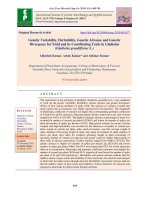
![Genetic variability studies in F2 segregating populations for yield and its component traits in Okra [Abelmoschu sesculentus (L.)Moench]](https://media.store123doc.com/images/document/2020_01/13/medium_nxs1578931693.jpg)
![Effect of precision farming techniques involving fertigation and mulching on growth attributes and seed yield of okra var. Arka Anamika [Abelmoschus esculentus (L.) Moench]](https://media.store123doc.com/images/document/2020_01/14/medium_ynr1578936108.jpg)
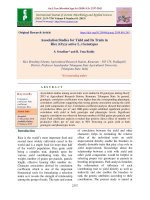
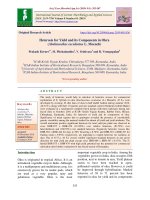
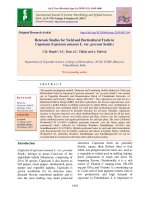
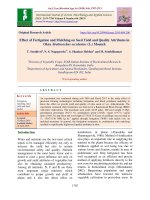
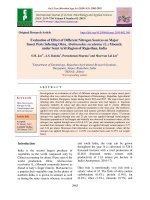
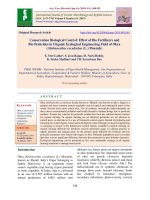
![Correlation and path coefficient analysis of fruits yield and yield attributes in okra [Abelmoschus esculentus (L.) Moench]](https://media.store123doc.com/images/document/2020_01/14/medium_ckb1578982226.jpg)